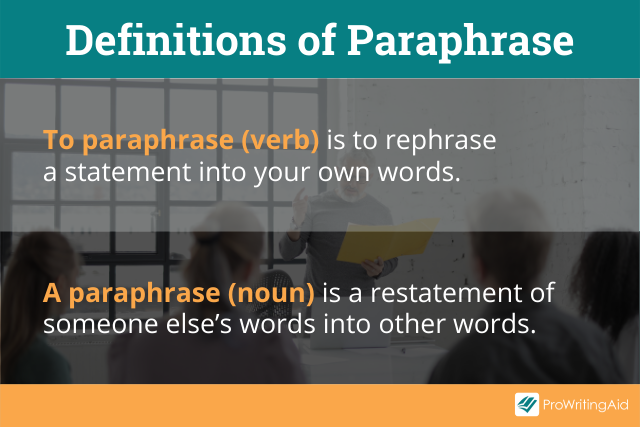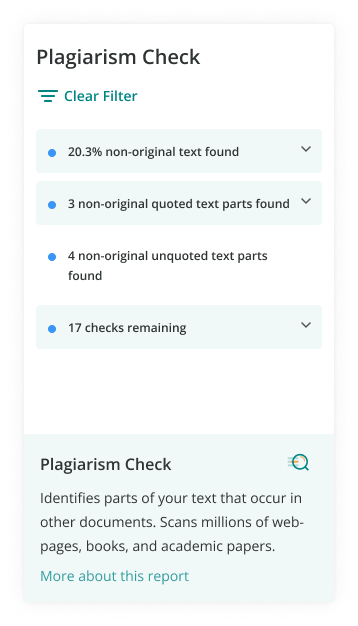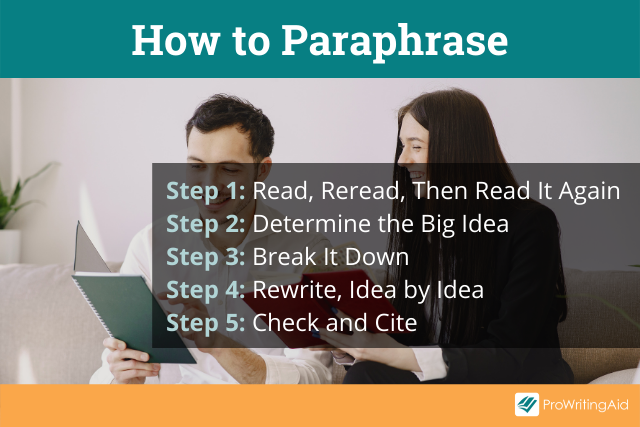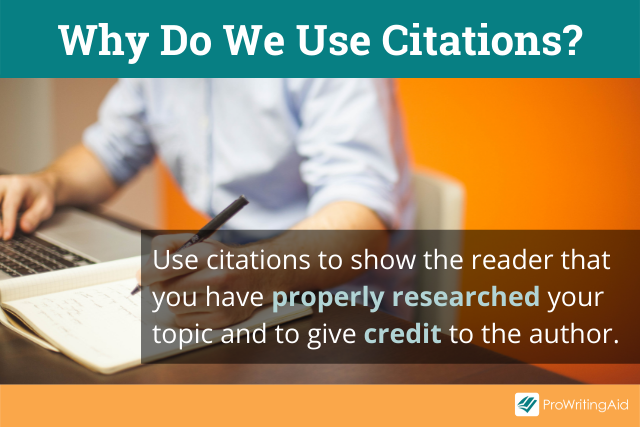
Paraphrasing is a tricky balance between using your own words and still getting the original message across.
Understanding what paraphrasing is, and how to do it well, takes the challenge out of paraphrasing and makes it a more user-friendly skill.
What Is Paraphrasing?
The word paraphrase can be used as a noun or a verb.
A paraphrase (noun) is a restatement of someone else’s words into other words. If you’re reading a paraphrase, you’re reading someone else’s rephrasing of the original.
To paraphrase (verb) is the act of rephrasing a statement into your own words. When you paraphrase, you are essentially borrowing someone else’s ideas and putting them into your own words. Since you’re borrowing and not creating those ideas, be certain to give credit to the original source.

Paraphrasing vs. Plagiarism
Plagiarism is when you steal someone’s words or ideas. Some people think that it’s only plagiarizing when you use the exact words.
Paraphrasing isn’t a way to steal someone’s ideas by putting it in your own words. If you’re paraphrasing someone else’s ideas, you must give them credit.
If you don’t acknowledge that source, you’ve plagiarized, which has serious ethical, and even legal, implications.
ProWritingAid can help you keep your work plagiarism-free with its plagiarism checker, and will never store or resell your work as some other plagiarism checking services sometimes do.

How to Paraphrase Properly
Why paraphrase when you could just use direct quotations? Direct quotes in academic writing and research papers do not demonstrate that you understand the original material.
Proper paraphrasing doesn’t mean rewriting the original passage word for word. It’s more than just pulling out a thesaurus. You are rewriting the ideas in your own words.
Just as you would provide the source of a direct quote, provide the source of paraphrased information according to whatever style guide you’re following (e.g. APA, MLA, Chicago, etc.) or by including the source within the paraphrase itself.
Typically, you’ll use an in-text citation alongside your paraphrased text, but sometimes you may use footnotes or endnotes.
When you use a direct quotation, it’s important to put the original passage or statement in quotation marks. But paraphrased text does not require quotation marks.
Paraphrasing is translating someone else’s words into your words. If you were to translate a sentence from one language into another going word-by-word, you’d end up with nonsense.
The same thing happens when you paraphrase. You’re performing a translation of sorts.
If you try to translate each word, you’ll end up with a paraphrase that reads more like a “word salad” than an intelligent rephrasing.
Why? When you isolate words, you take them out of their context.
The meaning of a word can change based on its context, so respect that context. Keep ideas whole to keep the original meanings intact.
Here’s what it looks like when you translate word for word.
Original Text: “Life expectancy isn’t set in stone: Both public policy and personal responsibility can tip the scales, experts said.” (Craig Schneider, Newsday)
If I paraphrase that text word-by-word, I could end up with something like this:
Word-by-Word Paraphrase: Human existences are not put in rocks. The pair of non-private systems and individual duty can point the measures, professionals uttered.
That makes no sense. Here’s a more effective paraphrase:
Proper Paraphrase: According to experts, public policy and individual choices can affect life expectancy.
This makes much more sense. Keep the entire context in mind when you paraphrase.
How to Paraphrase in 5 Easy Steps

There are some practical steps you can follow to ensure skillful paraphrasing. It might take some practice at first.
As you become more experienced with paraphrasing, you’ll notice that you follow these steps naturally.
Step 1: Read, Reread, Then Read It Again
You can’t properly paraphrase if you don’t fully understand the original passage. For effective paraphrasing, reread the original text multiple times.
Pay attention to word choice and tone, as those contribute to the overarching message. Be sure that you know exactly what the original author was trying to get across before you move on.
Step 2: Determine the Big Idea
There’s a difference between paraphrasing and summarizing, but a quick summary is a great starting point for a paraphrase.
A summary is the main idea. What is the big idea of the original passage?
Try to sum up the big idea in one sentence using your own words.
If you’re only paraphrasing a short chunk of text, this might be the extent of your work and you can skip to step five. For longer quotes, start with the gist.
Step 3: Break It Down
Once you have the big idea, you can start looking at the individual ideas. A good paraphrase includes all the essential information. This is the step where you determine which pieces are essential.
You can start breaking it down sentence by sentence, but keep in mind that you’re really trying to understand it idea by idea.
There might be one idea in two or three sentences or two ideas in one long sentence!
Step 4: Rewrite, Idea by Idea
Once you know all the essential information, it’s time to rewrite. Use your own words and phrasing as much as possible.
Of course, sometimes you will have to use some of the same words. For example, if you’re paraphrasing a quote about the economy, you don’t need to find a new word for “economy.”
Plagiarism isn’t just the words you use, but also the order those words are in.
If you do use more than two of the same words as the original in a row, place them in quotation marks. Avoid this as much as possible for a good paraphrase.
Once you’ve rewritten each idea with the important information, it’s time to make sure your paraphrased version accurately expresses the intent of the original passage.
That leads us to the final step.
Step 5: Check and Cite
Have you ever heard the phrase “lost in translation?” It’s true for paraphrasing, too. Sometimes, when we rewrite something in our own words, we lose the intent and meaning of the original.
Reread what you’ve written and ask yourself the following questions:
- Does this portray the same big idea?
- Have I included all relevant information and ideas?
- Does my paraphrase maintain the integrity of the original’s intent?
- Are all sentences written in my own voice and my own words?
If you can answer yes to all four questions, you’ve successfully paraphrased! If not, return to the quoted material and go through each step again.
Finally, add your citation. Always credit the original source so you don’t plagiarize.

Paraphrasing Different Types of Content
While the same basic steps apply no matter what you’re paraphrasing, it will look a little different depending on the type of text and why you’re paraphrasing.
Let’s take a look at three common situations that require paraphrasing.
How to Paraphrase in an Essay
Essays require paraphrases of many different quotes and sources.
While the occasional quote is fine, frequent direct quotes suggest that you don’t fully understand the material.
Your professor wants to know that you comprehend the subject and have thoughts of your own about it.
To paraphrase in an essay, start with a reasonable sized quote.
If the entire quotation is too long, your essay will become one giant paraphrase. You can always paraphrase another piece of the original text later in your paper.
Make sure the quote you are paraphrasing fits your thesis statement and is in the correct section of your essay.
Then, follow the five steps above to write a paraphrase. Don’t forget to cite your source material!
After you’ve paraphrased and cited the original text, offer your own commentary or thoughts.
How does that paraphrase answer the prompt of your research paper or support your argument? Original thoughts are crucial so your whole essay isn’t a paraphrase. That would be a form of plagiarism!
How to Paraphrase a Quote
Paraphrasing a quote requires you to pay special attention to the tone. Quoted material for academic writing often has a dry, informative tone. Spoken quotes usually don’t.
When you’re determining the big idea (step two), also determine the tone. You can note the tone in your paraphrase by saying the speaker was impassioned, angry, nostalgic, optimistic, etc.
When you move to step three and break down the ideas, pay attention to where the speaker placed emphasis. That’s a clue that you’ve found essential information to include in your paraphrase.
How to Paraphrase Complex Text
Complex and highly technical text can be difficult to paraphrase. All the same steps apply, but pay special attention to your words and sentence structure when you rewrite.

Whenever possible, simplify the complex text in your paraphrase.
Paraphrases are useful because they can make something easier to understand. Imagine that you are explaining the complex text to a middle school student.
Use simplified terms and explain any jargon in layman’s terms. Avoid clichés or idioms and focus only on the most essential pieces of information.
You can also use ProWritingAid’s editing tool to run a Jargon Report and a Cliché Report, as well as readability.
We use the Flesch-Kincaid Scale for readability, which is based on U.S. grade levels. You can see how old someone needs to be to understand your paraphrasing.
Your level of readability might change depending on the purpose of the paraphrase.
If you are paraphrasing complex text for a college-level essay, your readability score can be higher. If you are paraphrasing for a technical audience, some jargon is appropriate.
Paraphrasing Examples
Let’s take a look at a couple of examples of properly paraphrased material.
Original Text: “Life expectancy isn’t set in stone: Both public policy and personal responsibility can tip the scales, experts said. Everyone can make choices that increase the odds of a longer life, said Cantor, of the Center for Socio-Economic Policy. Eating well, exercising, not smoking, getting enough sleep and staying in school are decisions made by each and every one of us, he said.” (Craig Schneider, Newsday)
Paraphrase: People do have some control over their life expectancy. While public policies matter, experts say personal choices can also affect how long you live and that making healthy lifestyle choices about food, sleep, education, and smoking is up to each individual.
Here’s another example from a speech.
Original Text: “We’ve got to accelerate the transition away from dirty energy. Rather than subsidize the past, we should invest in the future—especially in communities that rely on fossil fuels. That’s why I’m going to push to change the way we manage our oil and coal resources, so that they better reflect the costs they impose on taxpayers and our planet.” (President Barack Obama, State of the Union Address, January 12, 2016)
Paraphrase: President Obama emphasized the importance of investing in clean energy. He supports a shift in the way the country manages non-renewable resources to match the impact they have on both American citizens and the planet.
Remember, when you paraphrase, focus on the ideas, not rewriting word for word. Always cite your original source material even though you are using your own words.
(This article is an update to a previous version by Allison Bressmer.)
Want to improve your essay writing skills?
Use ProWritingAid!
Are your teachers always pulling you up on the same errors? Maybe you’re losing clarity by writing overly long sentences or using the passive voice too much.
ProWritingAid helps you catch these issues in your essay before you submit it.


